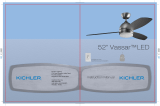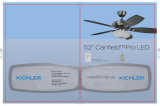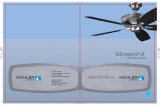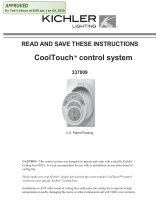Page is loading ...

2*
2*
Kichler
®
Lighting
7711 East Pleasant Valley Road
P.O. Box 318010
Cleveland, Ohio 44131-8010
Customer Service
866.558.5706
8:30 AM to 5:00 PM EST,
Monday - Friday
Instruction Manual
54” Link
TM
A Kichler
®
Décor
™
ceiling fan
Includes our new
CoolTouch
TM
Control System
Looks permanent, but goes wherever you go!
U.S. Patent Pending
HIGH
EFFICIENCY
DC
MOTOR
I
n
C
Lo
U.S.

1. To reduce the risk of electric shock, insure
electricity has been turned off at the circuit
breaker or fuse box before beginning.
2. All wiring must be in accordance with the
National Electrical Code and local
electrical codes. Electrical installation
should be performed by a qualified
licensed electrician.
3. WARNING: Suitable for use with solid-
state speed controls.
4. WARNING: To reduce the risk of personal
injury, use only the two steel screws (and
lock washers) provided with the outlet box
for mounting to the outlet box. Most outlet
boxes commonly used for the support of
lighting fixtures are not acceptable for fan
support and may need to be replaced,
consult a qualified electrician if in doubt.
5. The outlet box and support structure must
be securely mounted and capable of
reliably supporting a minimum of 50
pounds. Use only ETL Listed outlet boxes
marked "FOR FAN SUPPORT".
6. The fan must be mounted with a minimum
of 7 feet clearance from the trailing edge of
the blades to the floor.
7. To operate the reverse function on this
fan, press the reverse button while the fan
is running.
8. Avoid placing objects in the path of the
blades.
9. To avoid personal injury or damage to the
fan and other items, be cautious when
working around or cleaning the fan.
10. Do not use water or detergents when
cleaning the fan or fan blades. A dry dust
cloth or lightly dampened cloth will be
suitable for most cleaning.
11. After making the electrical connections,
spliced conductors should be turned
upward and pushed carefully up into
outlet box. The wires should be spread
apart with the ground wire and white
(common) wire to one side with the black
(load) wire to the other side of the outlet
box.
12. Electrical diagrams are reference only.
Light kits that are not packed with the fan
must be ETL Listed and marked suitable
for use with the model fan you are
installing. Switches must be ETL General
Use Switches. Refer to the Instructions
packaged with the light kits and switches
for proper assembly.
WARNING
TO REDUCE THE RISK OF FIRE, ELECTRIC
SHOCK OR PERSONAL INJURY, MOUNT
FAN TO OUTLET BOX MARKED
"ACCEPTABLE FOR FAN SUPPORT".
WARNING
TO REDUCE THE RISK OF PERSONAL
INJURY, DO NOT BEND THE BLADE
BRACKETS (ALSO REFERRED TO AS
FLANGES) DURING ASSEMBLY OR AFTER
INSTALLATION. DO NOT INSERT OBJECTS
IN THE PATH OF THE BLADES.
1
1. SAFETY RULES

2
3. PACKAGE CONTENTS
Unpack your fan and check the contents. You
should have the following items:
a. Fan blades (2)
b. Fan motor assembly
c. CoolTouch™ Control System
d. 4mm Allen wrench
e. Part bag contents
1) Mounting hardware :
wood screws (2), flat washers (2),
star washers (2), wire nuts (3),
screws (2)
2) Blade attachment hardware:
Allen screws with lock washers (9),
filat washers (9), gaskets (2)
3) Safety cable hardware:
wood screw, lock washer, flat washer
Philips screw driver
Blade screw driver
11 mm wrench
Step ladder
Wire cutters
2. TOOLS AND MATERIALS REQUIRED
a
b
c
d
e
54"Link
TM

4. MOUNTING OPTIONS
Outlet box
Outlet box
Fig. 1
Fig. 3
Outlet box
Fig. 2
3
If there isn't an existing ETL listed mounting
box, then read the following instructions.
Disconnect the power by removing fuses or
turning off circuit breakers.
Secure the outlet box directly to the building
structure. Use appropriate fasteners and
building materials. The outlet box and its
support must be able to fully support the
moving weight of the fan (at least 50 lbs). Do
not use plastic outlet boxes.
Figures 1, 2 and 3 are examples of different
ways to mount the outlet box.
NOTE: Depending on the location you have
selected for installation, you may need to
purchase and install a "Joist Hanger" for the
support of the outlet box. Make sure the joist
hanger you purchase has been designed for
use with ceiling fans. (Fig. 3)

4
Fig. 6
REMEMBER to turn off the power. Follow the
steps below to hang your fan properly:
Step 1. Attach the mounting plate to the outlet
box with the screws and washers provided
with the outlet box. Make sure the mounting
plate is tight and secured. (Fig. 5)
Step 2. Hang the fan motor assembly and
use the safety cable attached to the mounting
plate. This will allow you to use both hands
while make the electrical connections. (Fig. 6)
REMEMBER to turn off the power. Follow the
steps below to hang your fan properly:
Step 1. Remove the mounting plate from the
fan motor by removing the nuts. (Fig. 4)
Fig. 5
Fig. 4
6. HANGING THE FAN
CUL Listed
electrial
box
Mounting plate
5. REMOVE THE MOUNTING PLATE
Mounting
plate
Nut
Fan motor
Fan motor
Safety cable
54"Link
TM

5
Fig. 7
7. ELECTRICAL CONNECTIONS
WARNING: To avoid possible electrical shock,
be sure you have turned off the power at the
main circuit panel.
Follow the steps below to connect the fan to
your household wiring. Use the wire connecting
nuts suppled with your fan. Secure the
connectors with electrical tape. Make sure
there are no loose wire strands or connections.
Step 1. Connect the fan supply (black) wire to
the black household supply wire as shown in
Figure 12.
Step 2. Connect the neutral fan (white) wire to
the neutral household (white) wire.
Step 3. Connect the fan ground wire (green) to
the household ground wire.
Step 4. After connecting the wires, spread
them apart so that the green and white wires
are on one side of the outlet box and the black
and blue wires are on the other side.
Step 5. Turn the connecting nuts upward and
push the wiring into the outlet box.
White (neutral)
Green or bare
copper (ground)
White ("AC IN N")
Ground (green)
(Connect to ground wire
on hanger bracket if no
house ground wire exists.)
Outlet box
Black ("AC IN L")
Black (motor)

6
Fig. 8
Fig. 9
8. FINISHING THE INSTALLATION
Step 1. Move fan into position over the four
mounting studs and secure with the provided
nuts. (Fig. 8)
Step 2. Raise the motor housing up against
the mounting plate, the four supports inside
the housing should be placed against the four
studs on mounting plate, twist the housing
clockwise until snug. (Fig. 9)
Studs
Motor
housing
Nuts
Screws
54"Link
TM

7
Fig. 10
9. ATTACHING THE FAN BLADES
Step 1. Attach a blade to a blade bracket with
the Allen screws (with lock washers) and filat
washers and fasten using the Allen wranch
provided. (Fig. 10)
Place the gasket into blade bracket. Make
sure the blade is straight when set on the
blade bracket. Tighten each mounting screw
and then repeat this procedure for each blade.
Blade
Blade bracket
Allen screws with
lock washers
Allen wrench
Flat washers
Gasket

8
Fig. 11
Fig. 12
Make sure the power is completely disconnected
before you begin this procedure.
SPECIAL NOTE:
Your new Kichler
®
Ceiling Fan is State of the Art
and employs a High Efficiency DC (direct current)
Motor with an advanced CoolTouch™ Remote
Control System. The DC Motor uses 70% less
energy than a conventional ceiling fan AC
Induction Motor. The DC motor is “Digitally”
controlled and operates differently than
conventional ceiling fans motors. Please read this
portion of the manual completely before
proceeding.
Our CoolTouch™ Control system includes an
“Automatic Frequency Selection” feature. To set
the control frequency and program the control
system, follow these steps.
Open the back of the Transmitter (figure 11)
The Frequency Selector is a "Dip Switch Block"
inside the Battery compartment of the Transmitter.
(See figure 18) You change frequencies by
arranging the small switches numbered 1 through
4 in a up or down position. 16 possible
frequencies or combinations are possible.
The fifth switch, marked D and X sets the system
for operation with Incandescent or Fluorescent
Lamps. It is essential to set this switch correctly. If
your ceiling fan is equipped with Incandescent
Lamps set this switch to the D Position, for
Fluorescent Lamps, set the switch to the X
Position. If these settings are reversed, the
lighting control system will operate erratically and
could damage your ceiling fan.
System Programing: Read all of these steps
BEFORE proceeding. Each step must be followed
exactly to properly program the control system.
1. You can leave the frequency switches at the
factory setting or move them to any combination
of up or down. Use a small flat bladed screwdriver
to move the switches.
2. Insert both batteries and make sure they
are seated correctly in each recess with the
Positive + sign facing up. Replace the battery
cover. (Figure 11)
10. CONTROL SYSTEM SET-UP
ON
1 2 3 4
D
X
ON
Dip switch
54"Link
TM

9
Fig. 13
Fig. 14
Blue Light
Press/hold Button
3. Test the transmitter by pushing and releasing
ANY button briefly. A Blue Light should illuminate
under the 3-4 buttons. (Fig. 13) If not, check to
make sure the batteries are inserted and seated
correctly.
Power Up and Programming:
4. Follow the below steps to set the remote control:
The auto learning function will only mandate within
60 seconds when turning the fan’s AC power ON.
(Figure 14)
5. Select desired frequency from the back of
transmitter.
6. From the back of the transmitter, press “ ”
power button for 3 to 5 seconds. Light will blink
twice. The remote will now be programmed to your
fan and ready for use.
Try different speed setting on wall control to ensure
the fan is now fully functional. If programming is
unsuccessful, retry the process starting from step 6
again.
IMPORTANT: Do not interrupt the conditioning
until the fan comes to a complete stop in
approximately 5 minutes. All functions of the
control will be rejected during conditioning.
NOTE: The learning frequency function and self
calibration test will continue to retain the last set
frequency and calibration set even when the AC
power is shut off. If the frequency is changed the
self calibration test will occur again.
7. Your CoolTouch™ Control System is now
programmed and ready for use. Please see the
follow Operational Instructions.
The receiver provides the following protective
function:
1. Lock position: The DC motor has a built-in safety
against obstruction during operation. If there is an
obstruction, the motor will stop and then the power
will automatically go off in 30 seconds. Remove the
obstruction and reset.
2. Over 80W protection: When the receiver detects
motor power consumption which is greater than
80W, the receiver power will be stopped and
operation will immediately discontinue. Wait for 5
seconds and then turn the receiver power back on.

10
Fig. 15
Figure 15
1. Buttons 1, 2, 3, 4, 5 and 6 are used to set
the blade speed as follows:
1 = Low Speed
2 = Medium Low Speed
3 = Medium Speed
4 = Medium High Speed
5 = High Speed
6 = Extra High Speed
Figure 16
2. The " " button:
This button turns the fan motor off and is also
used in the program procedure.
3. The " " and " " button:
The " " button turns the upper light ON or
OFF and also controls the brightness setting
on some models. The " " button turns the
bottom light ON or OFF and also controls the
brightness setting.
Press and hold either button to set the desired
brightness level. The next time you turn the
light on, the system will remember this setting.
Press and release either button to turn the
light ON or OFF.
Figure 17
4. The " " button is used to set the fan in
forward or reverse operation. Each time you
press this button the fan blades will reverse
direction. This button functions ONLY when
the fan blades are in motion.
OPERATIONAL NOTE: Each time you start
the blades rotating, at any speed or reverse
the direction of the blades the Control System
will do a “Self Check” to insure operational
integrity. The blades will rotate slowly a short
distance (¼ turn), pause, change directions,
rotate ¼ turn, then build up RPM'S to the
selected speed. This is a perfectly normal
procedure and insures normal operating
performance.
11. OPERATING INSTRUCTIONS:
Fig. 16
Fig. 17
Motor Off Button
Light Control Buttons
Forward/Reverse
Button
Speed Buttons
54"Link
TM

11
Fig. 18
Fig. 19
NOTE: Please remember your control system
is an RF (Radio Frequency) control system.
You may occasionally experience control
problems because of other radio frequency
interference, i.e. fan turns off, light turns off or
won't turn on, speed changes, etc. If this
should happen, just change the “Control
Frequency” by turning the power off and
repeating steps 1 through 6 under System
Programming.
Speed settings for warm or cool weather
depend on factors such as the room size.
Ceiling height, number of fans and so on.
Warm Weather Operation: Forward (counter
clockwise) A downward airflow creates a
cooling effect as shown in Fig. 18. This allows
you to set your air conditioner on a warmer
setting without affecting your general comfort.
Cool Weather Operation: Reverse (clockwise).
An upward airflow moves warm air off the
ceiling areas as shown in Fig. 19. This allows
you to set your heating unit on a cooler setting
without affecting your general comfort.

SENSOR DC CONTROL PAIRING PROCEDURES
IMPORTANT: Ceiling fan blades MUST be installed before pairing procedure can
begin.
Step 1. Program the wall control and/or the handset control separately. Once the
following pairing is successfully done, both the wall control and the handset control
can be used for the fan.
For wall control, press the ȸȹ power button to turn off the wall control
(the button will be up). Restore electricity to the ceiling fan branch circuit at the
circuit breaker or fuse box. Within 60 seconds of turning on the power, press the
ȸȹ power button to turn on the wall control (the button will be down), and
then press the " " reverse button for 3 to 5 seconds. Light will blink twice (if
there is a light on the fan) and fan will run for approximately 2 minutes in the upward
direction then reverse direction to down flow for additional 2 minutes. After that the
fan will stop running. The remote will now be programmed to your fan and ready for
use.
F
For handset control,
restore electricity to the ceiling fan branch circuit at the
circuit breaker or fuse box. Within 60 seconds of turning on the power, press ȸȹ
power button for 3 to 5 seconds. Light will blink twice (if there is a light on the fan)
and fan will run for approximately 2 minutes in the upward direction then reverse
direction to down flow for additional 2 minutes. After that the fan will stop running.
The remote will now be programmed to your fan and ready for use.
IMPORTANT: Do not interrupt the conditioning until the fan comes to a complete
stop in approximately 5 minutes. All functions of the control will be rejected during
conditioning.
Step 2. Try different speed setting on both the wall control and the handset control to
ensure the fan is now fully functional. If programming is unsuccessful, retry the
process starting from step 1 again.

12
Fig. 20
Fig. 21
12. INSTALLING THE COOLTOUCH
™
CONTROL SYSTEM WALL PLATE
13. INSTALLING THE TRANSMITTER
1. Insert the transmitter into the wall plate by
inserting the bottom of the transmitter first and
then press the top of the transmitter into the
pocket. The transmitter will fully function from this
location or you can remove the transmitter and
use as a "Hand Held" device. (Fig. 22)
2. To remove the transmitter from the wall plate,
push the release button and the transmitter will fall
into your hand.
Wall plate
Switch
Outlet box
Screws
Screws
Plastic plugs
CoolTouch
™
wall plate
Outlet box
Metal plate
NOTE: All wiring must be in accordance with the
National Electrical Code and local electrical
codes. Electrical installation should be performed
by a qualified licensed electrician.
Select a location to install your CoolTouch™
Control System Transmitter. You can replace an
existing wall switch or, install the transmitter on
ANY flat surface.
Option 1: Install the control system using an
existing wall switch outlet box. Make sure the
electrical power is TURNED OFF at the main panel
before continuing.
NOTE: Switch installation must comply with all
local and national electric code.
Step 1. Remove the existing wall plate and the old
switch from the wall outlet box. Wire nut the
BLACK leads (hot) together and push back inside
the outlet box. (Fig. 20)
Step 2. Install the metal plate and CoolTouch™
wall plate to the existing wall outlet box with 4
screws provided. Then place the two plastic
plugs into the wall plate. (Fig. 21)
Option 2: Install the control system on ANY flat
surface.
Select the desired location and use the CoolTouch
™ wall plate to mark the location for the mounting
holes. Use the dry wall anchors and/or screws
provided and finish the installation.
Release
button
Fig. 22
54"Link
TM

13
Problem
Fan will not start.
Fan sounds noisy.
Fan wobble.
Remote control
malfunction.
Solution
1. Check circuit fuses or breakers.
2. Check all electrical connections to insure proper contact. CAUTION: Make
sure the main power is OFF when checking any electrical connection.
3. Make sure the transmitter batteries are installed properly. Positive (+) side
facing out.
4. Insure the batteries have a good charge.
1. Make sure all motor housing screws are snug.
2. Make sure the screws that attach the fan blade brackets to the motor are
tight.
3. Make sure wire nut connections are not rubbing against each other or the
interior wall of the switch housing. CAUTION: Make sure main power is off.
4. Allow a 24-hour "breaking-in" period. Most noise associated with a new fan
disappear during this time.
5. If using an optional light kit, make sure the screws securing the glassware are
tight. Make sure the light bulbs are not touching any other component.
6. Do not connect this fan to wall mounted variable speed control(s). they are
not compatible with ceiling fan motors or remote controls.
7. Make sure the upper canopy is a short distance from the ceiling. It should not
touch the ceiling.
1. Check that all blade and blade arm screws are secure.
2. Most fan wobbling problems are caused when blade levels are unequal.
Check this level by selecting a point on the ceiling above the tip of one of the
blades. Measure this distance. Rotate the fan until the next blade is positioned
for measurement. Repeat for each blade. The distance deviation should be
equal within 1/8".
3. If the blade wobble is still noticeable, interchanging two adjacent (side by
side) blades can redistribute the weight and possibly result in smoother
operation.
1. Ceiling Fans with remote control systems CAN NOT be operated in
conjunction with any other control system EXCEPT a basic On/Off wall switch,
if desired.
14. TROUBLESHOOTING
/













